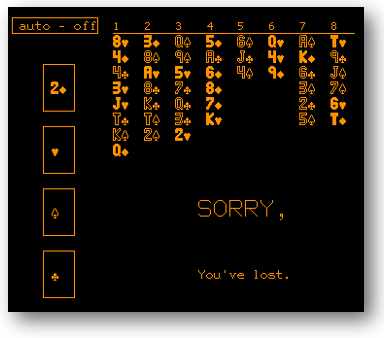
Free Cell as it appeared in the original 1978 version for the PLATO computer system. Baker's Game is a forerunner to this now infamous variety of solitaire.
Baker's Game is the name commonly given to a game described by amateur mathematician Martin Gardener which appears to be the main forerunner
to the populate FreeCell game. It differs from FreeCell in that in Baker's Game, cards are build by suit (whereas they are build in
sequences of alternating colours in FreeCell).
Martin Gardener introduced the game in his Mathematical Games column in Scientific American. He recounts how:
C. L. Baker, until recently a senior staff member of the computer sciences department of the Rand Corporation, has
called my attention to a little-known solitaire game he found could be simplified to provide an endless series
of intriguing combinatorial puzzles. The game was taught Baker by his father, who in turn learned it from an Englishman
during the 1920s. It differs from most solitaire games in that, although the initial pattern is determined by chance,
once the cards have been placed the player has complete information. Each initial layout is therefore solvable or unsolvable,
and finding a solution becomes a stimulating challenge.
Hence, a distinctive feature of the game as
Gardener introduced it— as you might expect, he was interested in the "puzzle" aspect of the game— was the fact that it could exist
in different combinations. He describes how "it was Baker's happy discovery that removing one, two or three suits from the full deck creates games of 'lower order.' For the three-suit,
or order-3 game, the cards are dealt into seven columns, and there are three P cells and three T cells...". (We will see below what these different "cell" types refer to...)
Solitaire Whizz therefore includes both 4-suit and 3-suit variants of the game.
How to play Baker's Game
Baker's Game is essentially played in a similar way to Free Cell, except that cards are built in suit sequence rather
than black/red alternating sequence, and that the game can be played with fewer than 4 suits.
Layout
Optionally, one suit is removed from the deck at random. Then, all cards are dealt face up into either 7 or 8 columns
(7 columns if you are playing with three suits; 8 if you are playing with four suits).
At the top of the layout, there are either three or four foundation piles, depending on the number of suits you are
playing with. As in Free Cell, there are also a number of empty "free cells" to the right of the foundations.
There are as many free cells as there are suits.
In his description of Baker's Game, Gardener actually referred to the
free cells as "T cells" for temporary cells. He referred to the foundations as "P cells" or play-off cells.
Aim
As in its better known Free Cell variant and in many other solitaire games, the aim is to build all cards on to the foundation piles, one pile per suit. As the Aces become available, build them on to the foundations, followed by the corresponding 2s etc.
Gameplay
With minor adaptations, Gardner describes the rules of the game as follows (his "B columns" or board columns are what we would now refer to as "tableau columns"):
- Only one card may be moved at a time.
- Only the top (uncovered) card may be moved from any B column.
- An ace may be played on any empty P cell. On top of it may be played the [two] of the same suit, then the three, and so on [up to] the king. These cards may come from the exposed ends of columns or from the T cells.
- An uncovered card in a B column may be shifted to become the uncovered card of another B column only if it goes on a next-higher card of the same suit.
- Any card may be played on an empty T cell and remain there until you wish to move it somewhere else.
- If a B column becomes empty, any movable card may be placed as a new starting card for that column.
Notice that any card can fill a new tableau column in Baker's game.
Moving Sequences of Cards
As with Free Cell, in the version of Baker's Game described by Gardener (in an era that essentially predates the personal computer!)
moves are made one card at a time. To speed up gameplay, in our modern version we allow sequences to be moved provided that enough T cells (i.e. free cells, remember!)
are available so that the cards in the sequence could technically have been moved one by one.
Martin Gardener's comments on Baker's Game
Unsurprisingly, Gardener's interest in Baker's Game was as much as a mathematical puzzle as a solitaire game as we might view it today. He comments:
All kinds of difficult combinatorial questions are posed by Baker's Game (I call it that because I have not so far discovered if the game\has a name).
Among many questions raised by Baker, and for which he has no answers, are the following. Does the probability of winning decrease as order-n
increases? If so, does it decrease to zero for some finite n or merely to some nonzero limit? For a given order what is the maximum number of
moves that may be required for a minimum-move solution? Can a computer program be written for finding minimum-move solutions to low-order games, or
even for testing whether or not a solution exists?
Even if your interest is not to dissect its mathematical properties, it is intriguing to try out Baker's Game as a forerunner
to what is now one of the most popular solitaire games ever played.